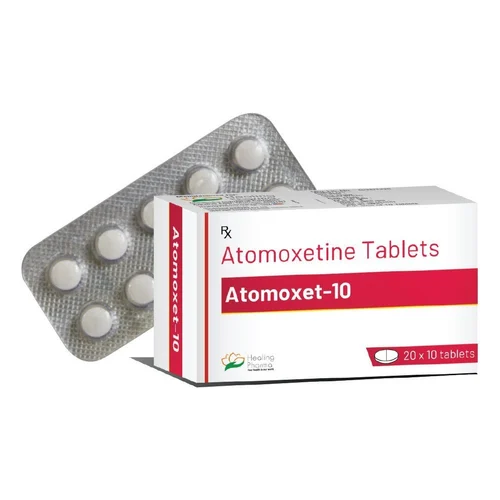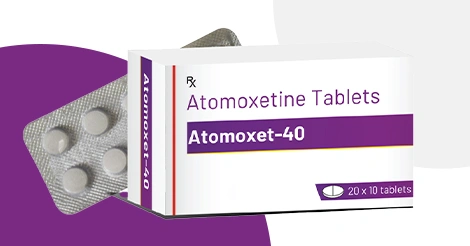Atomoxetine is a prescription medication used primarily to treat Attention Deficit Hyperactivity Disorder (ADHD) in children and adults. Unlike stimulants commonly used for ADHD, atomoxetine is a non-stimulant and works by increasing the levels of norepinephrine in the brain. This helps improve attention and reduces hyperactive and impulsive behavior.
Mechanism of Action
Atomoxetine’s efficacy stems from its ability to selectively inhibit the reuptake of norepinephrine, a neurotransmitter crucial for attention and impulse control. By blocking the norepinephrine transporter, atomoxetine increases its availability in the brain. This mechanism differs from stimulants, which primarily affect dopamine pathways, providing an alternative approach to ADHD treatment.
Approved Uses
While primarily prescribed for ADHD, atomoxetine has been explored for off-label uses in treating conditions such as anxiety and depression. Its non-stimulant nature makes it suitable for individuals with specific medical histories, offering flexibility in treatment plans. Understanding its approved and off-label uses can guide discussions with healthcare providers about its potential benefits.
Side Effects
Like all medications, atomoxetine can have side effects, although many are mild and manageable. Common side effects include stomach upset, decreased appetite, and fatigue. More serious side effects, though rare, may include liver damage or cardiovascular issues, highlighting the importance of regular medical monitoring during treatment.
The Cost of Atomoxetine Without Insurance
Before diving into how insurance affects pricing, it’s crucial to understand the baseline cost of atomoxetine without insurance coverage. The cost can vary based on several factors, including dosage, quantity, and the pharmacy you choose.
Generic vs. Brand Name
Atomoxetine is available in both generic and brand-name forms. The brand name for atomoxetine is Strattera. Generally, generic versions are less expensive than brand-name drugs. The price without insurance can range significantly, with generic versions often costing less than $100 for a monthly supply, whereas brand-name Strattera could exceed $400.
Dosage and Quantity
The specific dosage and quantity required can significantly impact the overall cost. Higher dosages or larger quantities typically result in higher expenses. Patients should work closely with their healthcare providers to determine the most effective and cost-efficient dosage, balancing therapeutic benefits with affordability.
Pharmacy Variability
Pharmacy pricing can also affect the cost. Different pharmacies may charge different prices for the same medication, so it pays to shop around or use online tools to compare prices at various pharmacies in your area.
Geographic Location
The geographic location can also influence the price of atomoxetine. In some regions, medication costs can be higher due to local market conditions and pharmacy competition. Understanding these regional variations can help patients identify more affordable purchasing options.
How Insurance Affects Atomoxetine Pricing
Insurance can significantly impact the cost of atomoxetine, but the extent varies depending on several factors, including your insurance plan, whether the drug is generic or brand-name, and the pharmacy benefit manager (PBM) involved.
Insurance Plan Coverage
Insurance plans usually have a formulary, which is a list of medications covered by the insurance. Atomoxetine might be on this list, but its tier level will affect how much you pay. Tiers are determined by the cost and necessity of the medication, with lower tiers having lower copays. If atomoxetine is in a higher tier, you may face higher out-of-pocket costs.
Formularies and Tier Levels
Formularies categorize medications into tiers based on cost and therapeutic value. Lower-tier drugs typically incur lower copays, while higher-tier drugs require greater out-of-pocket expenses. Understanding your plan’s formulary can guide effective budgeting for atomoxetine expenses.
In-Network vs. Out-of-Network
The network status of pharmacies can influence costs. In-network pharmacies usually offer medications at lower prices due to negotiated rates with insurance companies. Conversely, out-of-network pharmacies might result in higher costs, emphasizing the importance of choosing in-network options.
Generic vs. Brand Name in Insurance
Insurance companies often favor generic drugs because they are more cost-effective. If you have insurance, you’re likely to pay less for the generic version of atomoxetine than for the brand-name Strattera. In some cases, insurance might not cover the brand name at all unless a doctor can justify its necessity over the generic option.
Brand Name Preferences
While generics are typically favored, some patients may need the brand-name drug due to individual responses or allergies. In such cases, doctors can submit a request for brand-name coverage, although approval is not guaranteed. Exploring this option can be crucial for patients with specific needs.
Step Therapy Protocols
Insurance plans may require step therapy protocols, where patients must try and fail cheaper medications before covering more expensive ones like brand-name Strattera. Understanding these protocols helps patients prepare for potential delays and additional steps in receiving their medication.
Deductibles and Copays
Your insurance deductible is the amount you must pay out-of-pocket before your insurance begins to cover costs. If you haven’t met your deductible, you may pay the full price for atomoxetine. Once your deductible is met, your copay will determine your cost, which is typically a fixed amount depending on your insurance plan’s tier structure.
Navigating Deductibles
Deductibles reset annually, impacting medication costs at different times of the year. Patients should plan for these changes, potentially adjusting their medication budget accordingly. Exploring supplemental insurance options can also help mitigate these costs.
Copay Assistance Programs
Some pharmaceutical companies offer copay assistance programs to reduce out-of-pocket expenses for medications. These programs can significantly lower the financial burden, particularly for patients with high copays. Investigating these opportunities can provide substantial savings.
Prior Authorization
Some insurance plans require prior authorization for atomoxetine, especially if opting for the brand-name version. This process requires your healthcare provider to justify the medical necessity of the drug, potentially adding time before you can get your prescription filled.
Streamlining the Authorization Process
Understanding the prior authorization process can reduce delays in obtaining medications. Patients should work closely with their healthcare providers to ensure necessary documentation is submitted promptly. Keeping open communication with insurance representatives can also expedite approvals.
Impact on Medication Access
Prior authorization can affect timely access to medications, potentially disrupting treatment plans. Patients should prepare for these contingencies by discussing alternative options with their healthcare providers. Exploring emergency prescription assistance can also provide interim solutions.
Benefits of Atomoxetine

Despite the costs, the benefits of atomoxetine make it a valuable medication for many. Understanding these benefits can help justify the expense, whether you’re paying out-of-pocket or through insurance.
Non-Stimulant Option
For those who cannot tolerate stimulants due to side effects or potential for abuse, atomoxetine offers an effective alternative. It’s especially beneficial for individuals with a history of substance use disorders.
Suitability for Diverse Patients
Atomoxetine’s non-stimulant profile makes it suitable for a wide range of patients, including those with co-existing mental health conditions. Its safety and efficacy profile supports its use in various demographic groups, ensuring broader accessibility.
Minimal Abuse Potential
Unlike stimulants, atomoxetine has a low potential for abuse, making it a safer option for individuals with substance use concerns. This characteristic contributes to its preference among certain patient populations and healthcare providers.
Long-Lasting Effects
Atomoxetine is generally taken once or twice a day and provides continuous symptom control throughout the day, unlike some stimulants that may require multiple doses.
Consistent Symptom Management
The long-acting nature of atomoxetine ensures consistent symptom control, reducing the need for frequent dosing. Patients benefit from stable therapeutic effects, enhancing daily functioning and quality of life.
Simplified Medication Regimen
A simplified dosing schedule improves medication adherence, crucial for effective ADHD management. Patients are less likely to miss doses, ensuring optimal therapeutic outcomes and minimizing treatment disruptions.
Improvement in ADHD Symptoms
Studies have shown that atomoxetine significantly improves ADHD symptoms, enhancing quality of life, social interactions, and performance in academic or occupational settings.
Enhanced Cognitive Function
Atomoxetine contributes to improved cognitive function, including attention span and executive functioning. These improvements translate into better academic and occupational performance, supporting personal and professional development.
Positive Impact on Social Interactions
By reducing impulsivity and enhancing attention, atomoxetine fosters better social interactions. Improved interpersonal skills lead to stronger relationships and enhanced social integration, contributing to overall well-being.
Tips for Managing Atomoxetine Costs
Here are some strategies to help manage the cost of atomoxetine, whether you have insurance or not:
Use Prescription Discount Cards
Many pharmacies accept prescription discount cards, which can significantly lower the cost of atomoxetine. These cards are available online and can be used in conjunction with or instead of insurance.
Maximizing Savings
Patients can maximize savings by using multiple discount cards, comparing discounts offered by different providers. Regularly checking for new or updated discount programs can also ensure continued access to cost-effective pricing.
Combining with Insurance
In some cases, discount cards can be used alongside insurance, further reducing out-of-pocket expenses. Patients should confirm with their pharmacy whether this combination is possible, optimizing potential savings.
Explore Manufacturer Assistance Programs
Some pharmaceutical companies offer assistance programs for those who cannot afford their medications. Check if there are any programs available for atomoxetine.
Eligibility Criteria
Eligibility for manufacturer assistance programs varies, often based on income or insurance status. Understanding these criteria and gathering necessary documentation can facilitate the application process, expediting access to support.
Application Process
The application process for assistance programs may require detailed information, including medical and financial documentation. Patients should be prepared to provide comprehensive data, ensuring a smooth and successful application.
Consult with Your Healthcare Provider
If cost is a barrier, talk to your healthcare provider. They might be able to prescribe a lower-cost alternative or provide samples to help you manage expenses.
Exploring Alternative Medications
Healthcare providers can explore alternative medications or treatment strategies that offer similar benefits at lower costs. Collaborative discussions can identify optimal solutions, balancing therapeutic efficacy with affordability.
Accessing Medication Samples
Providers often have access to medication samples, offering a temporary solution while patients explore long-term cost-saving measures. Samples can bridge gaps in medication access, maintaining treatment continuity.
Regularly Review Your Insurance Plan
Insurance plans can change annually. Reviewing your plan during open enrollment can help ensure that you have the best coverage for your medication needs.
by National Cancer Institute (https://unsplash.com/@nci)
Analyzing Plan Benefits
A thorough analysis of insurance plan benefits can identify potential savings opportunities. Patients should compare plan options, focusing on formularies, premiums, and out-of-pocket costs to ensure comprehensive coverage.
Adjusting Coverage as Needed
Changes in medication needs or financial circumstances might necessitate adjustments in insurance coverage. Proactive plan reviews allow for timely modifications, ensuring optimal support for ongoing medication expenses.
Conclusion
Understanding how insurance affects atomoxetine pricing can help you make informed decisions about your ADHD treatment plan. While costs can vary, having the right information and strategies can ease the financial burden. Always consult with healthcare providers and insurance representatives to find the best options for your needs. With the right approach, managing the cost of atomoxetine can be more straightforward, allowing you to focus on its benefits for managing ADHD symptoms.


